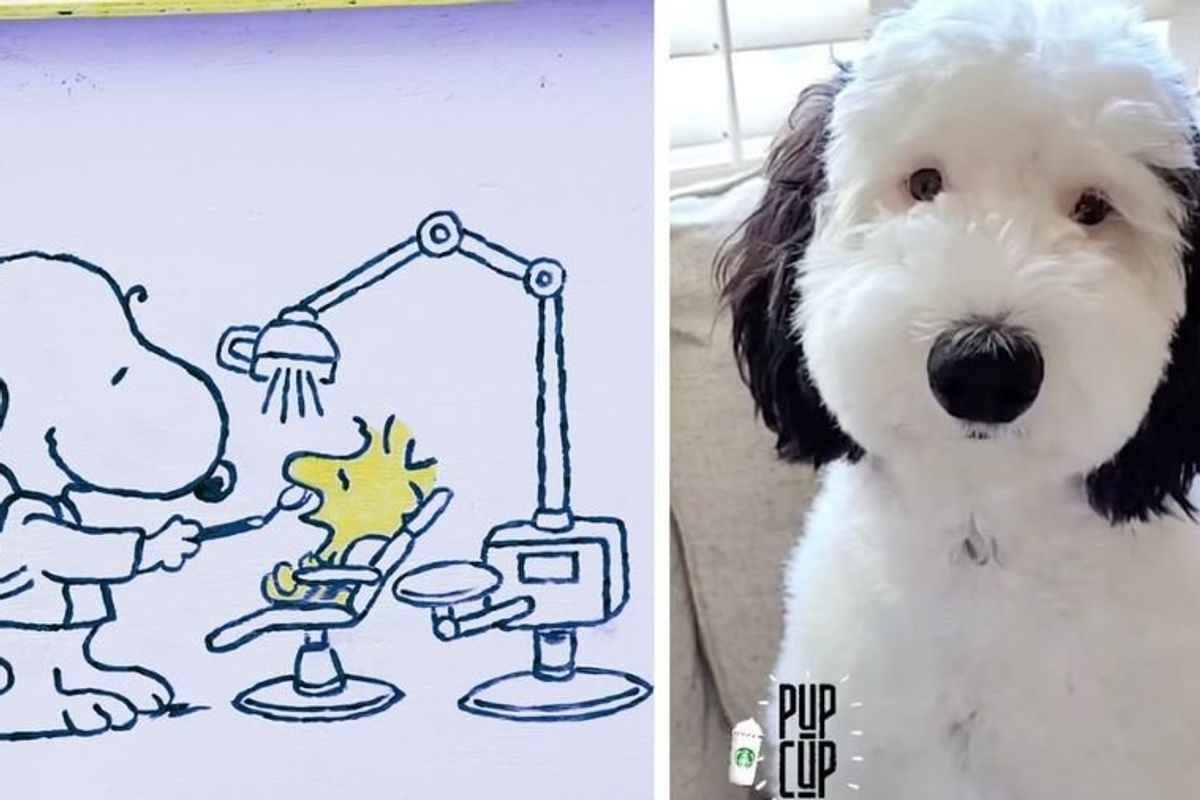Snoopy is real, her name is Bayley and the internet can't get enough of her
Everyone's childhood hearts just melted into a puddle.

Stop what you're doing. There's a dog that looks just like Snoopy.
Soooo, there's this dog and I'm pretty sure it's the actual Snoopy come to life. Seriously all the dog needs is a red dog house out back and a little yellow bird that follows it around. If you think it can't be true, then you're going to have to fight the entire internet about it because nobody can get enough of how much this sweet dog looks like the iconic cartoon character.
Snoopy is Charlie Brown's pet from the comic strip "Peanuts" that eventually spawned several movies and cartoon series, and Bayley is a dead ringer for the black and white animated pup. Since we live in a digital age, people across the country have been falling all over themselves to get to the pooch's Instagram account and admire her cartoonish mug.
Bayley is a 1-year-old mini sheepadoodle, which is a cross between a miniature poodle and an Old English Sheepdog. Her sweet face is something you have to see to believe and even then you may question if she's real.
The dog's perfectly groomed curly fur makes her face look fluffy and cartoon-like. Once you add in her black ears and black button nose, that honestly looks more like a smooth lump of coal than a dog nose, then you have the perfect Snoopy doppelgänger. Bayley came into her viral fame after Doodle Dogs Club shared her photo on their Instagram account that has over 230,000 followers, and just like that, she was "famous."
The introductory post of the live version of Charlie Brown's best friend racked up over 1.4 million likes and 10.3K comments. The comments ranged from people reminding others that the fictional dog was a Beagle to people demanding Bayley star in the live action version of Charlie Brown.
Whether Snoopy was a Beagle or not, there's no arguing that Bayley looks more like the cartoon canine than real life Beagles. This probably has a lot to do with cartoons being...cartoons. Everything tends to be a bit bubbly and over exaggerated with cartoons.
Charlie Brown was supposed to be between the ages of 4 and 8 years old according to PeanutsWiki, who busted out the comic strip receipts. If cartoons looked exactly like real life, poor Charlie Brown would have a hard time walking with his oversized noggin.
Bayley's curly fluffy fur gives her an advantage over actual Beagle's when it comes to the ability to look like the famous cartoon character. It's something she probably couldn't care less about, unless every time she got compared to Snoopy equaled a dog treat. Otherwise, I'm sure the black and white sheepadoodle is perfectly happy just being a dog wondering why suddenly her mom keeps taking pictures of her.
Since Bayley's debut on Doodle Dogs Club, the animated dog come to life has climbed up to over 240k followers and her fanbase just can't get enough of her. To make people love her even more, the dog's mom uploads videos of Bayley using audio that makes it sound like the pup is a toddler trying to tell a story.
Check out some of the love Bayley gets on her Instagram account.
This article originally appeared on 4.17.23





 A father does his daughter's hair
A father does his daughter's hair A father plays chess with his daughter
A father plays chess with his daughter A dad hula hoops with his daughterAll illustrations are provided by Soosh and used with permission.
A dad hula hoops with his daughterAll illustrations are provided by Soosh and used with permission. A dad talks to his daughter while working at his deskAll illustrations are provided by Soosh and used with permission.
A dad talks to his daughter while working at his deskAll illustrations are provided by Soosh and used with permission. A dad performs a puppet show for his daughterAll illustrations are provided by Soosh and used with permission.
A dad performs a puppet show for his daughterAll illustrations are provided by Soosh and used with permission. A dad walks with his daughter on his backAll illustrations are provided by Soosh and used with permission.
A dad walks with his daughter on his backAll illustrations are provided by Soosh and used with permission. a dad carries a suitcase that his daughter holds onto
a dad carries a suitcase that his daughter holds onto A dad holds his sleeping daughterAll illustrations are provided by Soosh and used with permission.
A dad holds his sleeping daughterAll illustrations are provided by Soosh and used with permission. A superhero dad looks over his daughterAll illustrations are provided by Soosh and used with permission.
A superhero dad looks over his daughterAll illustrations are provided by Soosh and used with permission. A dad takes the small corner of the bed with his dauthterAll illustrations are provided by Soosh and used with permission.
A dad takes the small corner of the bed with his dauthterAll illustrations are provided by Soosh and used with permission. Side Eye Dog Meme GIF
Side Eye Dog Meme GIF Meme Reaction GIF by Tokkingheads
Meme Reaction GIF by Tokkingheads When the parents don't even know about it, that's a successful surprise party.
When the parents don't even know about it, that's a successful surprise party.